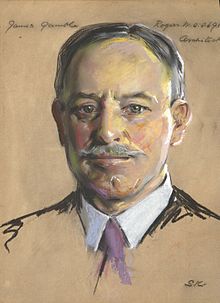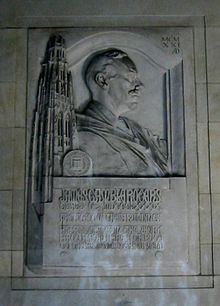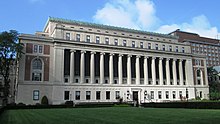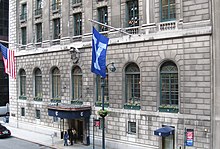James Gamble Rogers
James Gamble Rogers | |
|---|---|
 Portrait byWilliam Sergeant Kendall | |
| Born | March 3, 1867 Bryan Station,Kentucky,U.S. |
| Died | October 1, 1947(aged 80) New York City,U.S. |
| Nationality | American |
| Occupation | Architect |
| Buildings | AtYale University:
In New York City:
Elsewhere: |




James Gamble Rogers(March 3, 1867 – October 1, 1947) was an American architect. A proponent of what came to be known asCollegiate Gothicarchitecture, he is best known for his academic commissions atYale University,Columbia University,Northwestern University,and elsewhere.[1]
Biography
[edit]Rogers was born inBryan Station,Kentucky,on March 3, 1867, to James M. and Katharine Gamble Rogers.[1][2]Rogers attendedYale University,where he contributed toThe Yale Recordand was a member of the senior societyScroll and Key,[2]whose membership included several other notable architects. He received his B.A. in 1889, and is responsible for many of thegothic revivalstructures at Yale University built in the 1910s through the mid-1930s, as well as the university's master plan in 1924.[2]He designed buildings for other universities as well, such as theButler LibraryatColumbia Universityand several buildings atNorthwestern University,notablyDeering Library.[2]
Rogers designed most of the original buildings at theColumbia-Presbyterian Medical Center(now theNewYork-Presbyterian/Columbia University Irving Medical Center), which was the world's firstacademic medical center.
He died in New York City on October 1, 1947.[2]
Legacy
[edit]Rogers was philanthropistEdward Harkness's favorite architect, and Harkness would often condition a gift for a new academic or medical building upon the institution's agreement to hire Rogers for the project. It is thus no coincidence that Rogers' work is abundant at Yale, Columbia and the other institutions Harkness supported lavishly. Even though Harkness admired Rogers's work, when Harkness donated a new home forWolf's Head,his society at Yale, another architect (Bertram Goodhue) was chosen.
Rogers'Collegiate Gothicdesigns for Yale lent an air of instant heritage and authenticity to the campus. Rogers was criticized by other prominent Gothic-revival American architects, namelyRalph Adams Cram,for his use of steel frames underneath stone cladding, and tricks such as splashing acid on stone walls to simulate age. Rogers was also criticized by the growingModernistmovement of the time. The 1927Sterling Memorial Librarycame under especially vocal attack from Yale students for its historicist spirit and its lavish use of ornament. But current opinion generally regards the building as a triumph, being both beautiful and functional.
Rogers's nephew,James Gamble Rogers II(1901–1990) was also an architect, who designed homes inWinter Park, Floridafor the Rogers family architecture firm Rogers, Lovelock and Fritz, where Rogers II's son John (Jack) Rogers is a principal architect.
Rogers II's other son,James Gamble Rogers IV(1937–1991) was also trained as an architect. After working in the family firm as a young man, James Gamble Rogers IV decided to pursue his passion for music. He became a noted Florida folksinger, composer and guitarist, now memorialized by the Gamble Rogers Memorial Foundation,[3]Gamble Rogers Middle School, andGamble Rogers Memorial State Recreation Area at Flagler Beachon Florida's east coast.
James Gamble Rogers'architectural drawingsand photographs are now held in the Dept. of Drawings & Archives in theAvery Architectural and Fine Arts LibraryatColumbia Universityin New York. A number of his built works are listed on theNational Register of Historic Places(NRHP).
Buildings
[edit]This sectionneeds additional citations forverification.(December 2014) |
- Lees Building(1893), Chicago, Illinois (now demolished)
- Hyde Park Union Church(1906), Chicago, Illinois
- Laurel CourtMansion (1907), Cincinnati, Ohio, also known as Peter G. Thomson House (residence of his aunt Laura Gamble Thomson), NRHP-listed[4]
- TheEdward S. Harkness House(1908), 1 East 75th Street at Fifth Avenue, Manhattan. Constructed as the residence ofEdwardandMary Stillman Harknessin 1908. Currently the home ofThe Commonwealth Fund,the organization they founded for their philanthropic work. Designated a landmark in 1967.
- Shelby County Courthouse(1909), Memphis, Tennessee
- Federal Courthouse (1913), New Haven, CT.
- Plan and buildings of TheH. Sophie Newcomb Memorial College(1913),Tulane University,New Orleans
- Brooks Museum of Art(1913), Memphis, Tennessee.
- The former Bridgeport High School, now City Hall (1914–16), Bridgeport, Connecticut.
- TheYale Club of New York City(1915), Midtown Manhattan.
- Burnham Park Plaza(1915), Chicago.
- Hsiang Ya Hospital (1918) inChangsa,China.
- Harkness Memorial Quadrangle(later renovated and subdivided by Rogers in 1933 intoBranfordandSaybrook Colleges) andHarkness Memorial Tower(1921), Yale University.
- The Goodwyn(1922),Memphis, Tennessee
- Yale's General Plan (1924)
- Bob Cook Boat House(1924), Yale University.
- English Country Estate (1926), 990 East Illinois Road, Lake Forest, Illinois
- Dyche Stadium(1926),Northwestern University.[5]
- Wieboldt Hall(1926), Northwestern University, Chicago campus
- Methodist Church (1926), now University United Methodist Church, Chapel Hill, North Carolina
- Yeamans Hall Club(1926), Hanahan, South Carolina
- Ward Memorial Building(1926), Northwestern University, Chicago campus (funded by Elizabeth Ward in honor of her late husband, mail order and department store magnateAaron Montgomery Ward.)
- Beta Theta Pi(1927), Fraternity Row, Yale University.
- James Gamble Rogers House (1927), 424 West Mountain Road, Ridgefield, CT, in NRHP-listedWest Mountain Historic District
- Psi Upsilon(1928), later theFence Club,Fraternity Row, Yale University
- Harkness Pavilion (1928),NewYork–Presbyterian Hospital
- Ossining High School(1928), Ossining, New York
- Vanderbilt School of Dental and Oral Surgery (1928), Columbia Presbyterian Medical Center.
- Neurological Institute of New York (1928),NewYork–Presbyterian Hospital.
- College of Physicians and Surgeons(1928),Columbia University Medical Center
- Presbyterian Hospital Building (1928),NewYork–Presbyterian Hospital.
- Joseph L. Mailman School of Public Health(1929),Columbia University Medical Center.
- School of Education (1930),New York University,Greenwich Village.
- Sterling Memorial Library(1930), Yale University.
- Delta Kappa Epsilon(1930), Fraternity Row, Yale University.
- Sterling Law Building(1931), Yale University.
- Alpha Delta Phi(1931), 215 Park Street, Fraternity Row, Yale University.
- University Theater and Drama School(1931 renovation), Yale University.
- AetnaHome Office (1931), Hartford, CT.[6][7]
- Phi Gamma Delta/ Vernon Hall (1932), 217 Park Street, Fraternity Row, Yale University.
- Hall of Graduate Studies(1932), Yale University.
- Jonathan Edwards College(1932) including Weir Hall addition, Yale University.
- Pierson College(1932), Yale University.
- Davenport College(1932), Yale University.
- Briton Hadden Memorial Building(1932), Yale Daily News
- Deering Library(1933), Northwestern University, Evanston campus.
- Trumbull College(1933), Yale University.
- Berkeley College(1933), Yale University.
- Butler Library(1934), Columbia University, (as South Hall; renamed in 1946 in honor ofNicholas Murray Butler,president of the university from 1902 to 1945)
- Timothy Dwight College(1935), Yale University.
- Memorial Sloan-Kettering Hospital(1939), Memorial Sloan-Kettering Medical Center.
- Scott Hall / Cahn Auditorium (1940), Northwestern University, Evanston campus.
- Harkness Chapel (1940),Connecticut College,New London.[8]
- Harkness Hall, Clark Atlanta University, Atlanta, Ga.
- Riegel Ridge Community Center,Co. Rt. 519, approximately 1.5 mi N of NJ-PA state line, Holland Township, Milford, NJ, NRHP-listed
- Rutherford Health Department,303 N. Church St., Murfreesboro, TN, NRHP-listed
References
[edit]- ^ab"Rogers, James Gamble (1867 - 1947) -- Philadelphia Architects and Buildings".philadelphiabuildings.org.
- ^abcdeObituary Record of Graduates of Yale University Deceased During the Year 1946-1947 (also called Obituary Record of Graduates Deceased During the Year Ending July 1, 1947),New Haven, Connecticut: Bulletin of Yale University, 1948, pp. 19–20
- ^"Gamble Rogers Memorial Foundation: Welcome".
- ^"James Gamble Rogers - Architect of Laurel Court".laurelcourt.com.RetrievedFebruary 7,2010.
- ^"Ryan Field".football.ballparks.com.Ballparks.com. Archived fromthe originalon January 20, 2017.RetrievedDecember 20,2014.
- ^"Aetna History".aetna.com.
- ^"Yale Finding Aid Database: Guide to the James Gamble Rogers Papers".yale.edu.
- ^"Connecticut College - Religious and Spiritual Life - Harkness Chapel".Archived fromthe originalon 2006-03-14.Retrieved2006-04-11.
Sources
[edit]- James Gamble Rogers and the Architecture of Pragmatism,Aaron Betsky, MIT, 1994.ISBN978-0262023818
- The Architecture of James Gamble Rogers II in Winter Park, Florida,Patrick and Debra McClane, 2004.ISBN0-8130-2770-5
- The Campus Guide: Yale University,Patrick L. Pinnell, Princeton Architectural Press, New York, 1999.ISBN978-1616890643
- Yale: A Pictorial History,Reuben A. Holden, New Haven, Yale University Press, 1967.
- Yale in New Haven: Architecture and Urbanism,Vincent Scully, Catherine Lynn et al., New Haven, Yale University Press, 2004,ISBN978-0974956503
